 |
|
 02-13-2020, 01:56 AM
02-13-2020, 01:56 AM
|
#1
|
|
Site Team
Join Date: Mar 2019
Location: South Bend, WA
Posts: 2,770
|
Winterizing a 22M using the blow-out method
To keep my water lines clean, I purchased a new oil-free compressor and a new hose. Here is the process I used. - Assured that the Black and Grey tanks are empty, and then close their dump valves.
- Open the 45 gallon Fresh Water Tank Drain (found under the water pump) and leave it open.
- Remove the 6 gallon Hot Water Heater Plug with a 1&1/16" socket.

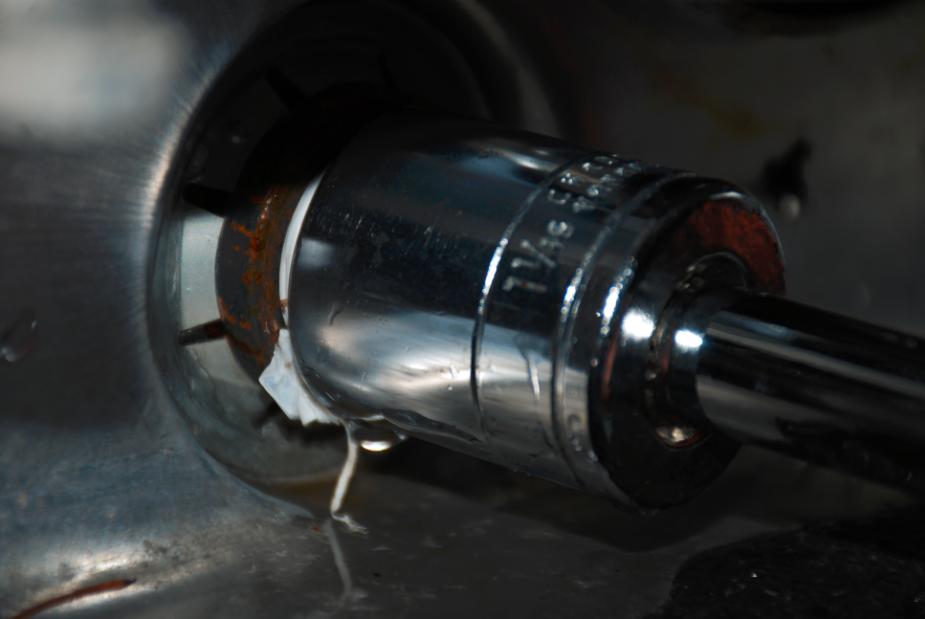 - Open the 3 Winterizing Drains

Also open: - The Hot & Cold of the kitchen sink
- The Hot & Cold of the bathroom sink
- The Hot & Cold of the shower, with the shower head lowered to the shower floor.
Once gravity-drained, close ... - ... the kitchen sink valves
- ... the bathroom sink valves
- ... the shower valves
- ... the Winterizing Valves
Reinstall the Hot Water Heater Plug with fresh Teflon tape. - Leave the 45 gallon Fresh Water Tank Drain open for the winter.
- Screw-in the Blowout plug to the City Water connection.
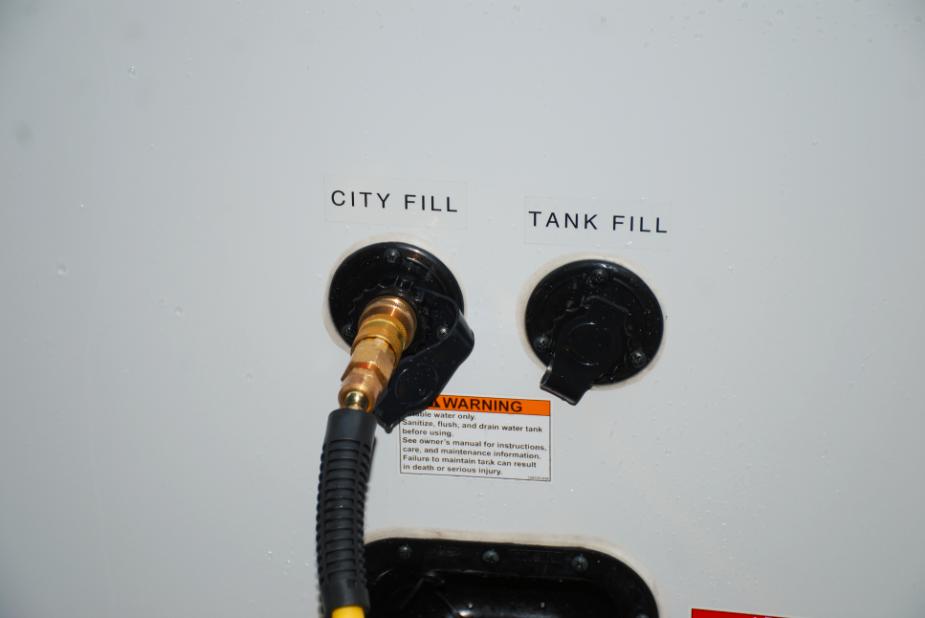 - The Compressor hooked-up and ready-to-go:
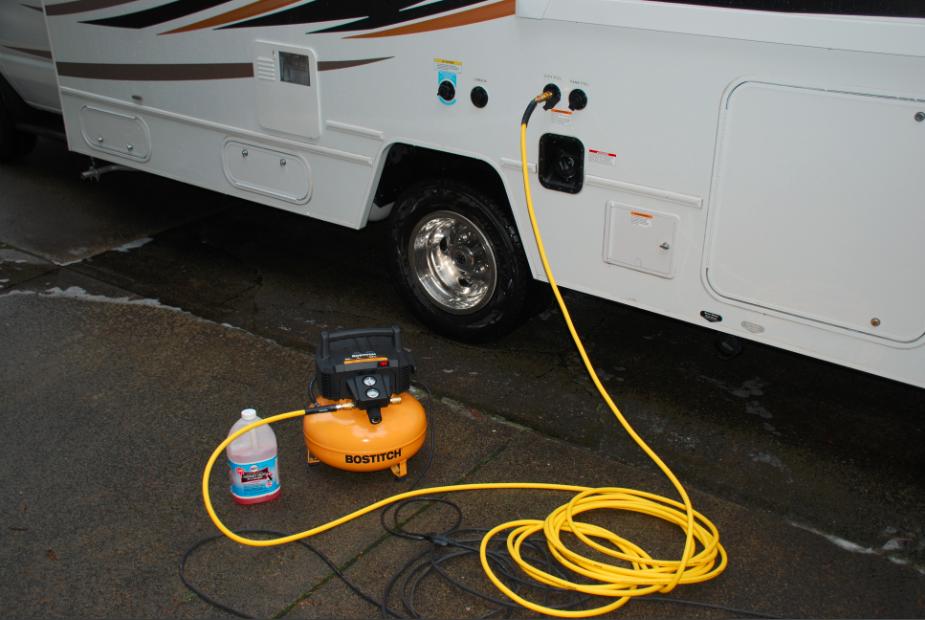 - Set the Compressor regulator from 20 psi to 40 psi.
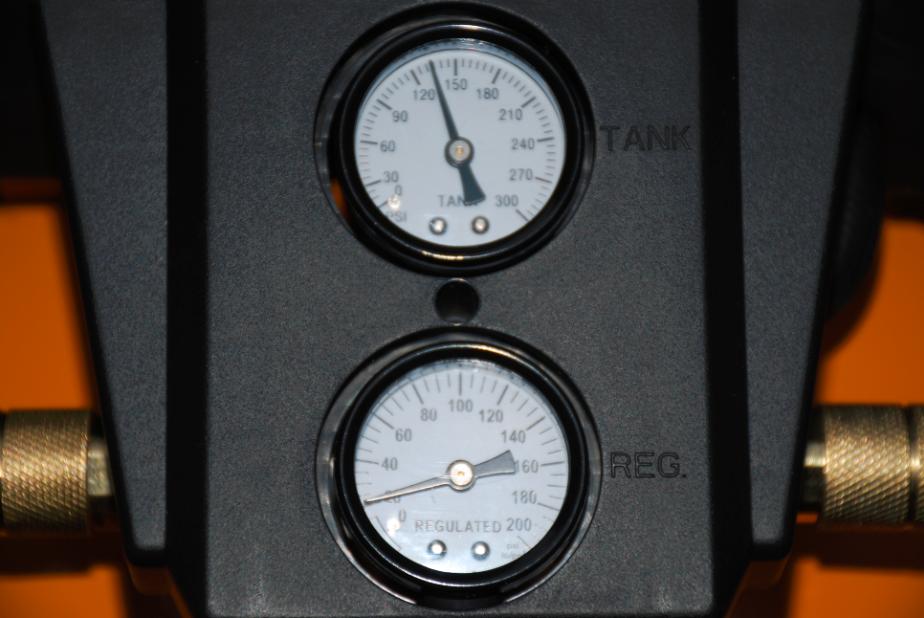
Open the valves to blow-out the water, but just one fixture at a time: - The kitchen sink
- The toilet flush lever
- The bathroom sink
- The shower
- The three winterizing drains
Repeat the above sequence one extra time to assure that the system is purged. - Remove the compressor.
- Re-open all of the valves.
- Remove the water pump filter to allow it to drain too, then replace the filter.
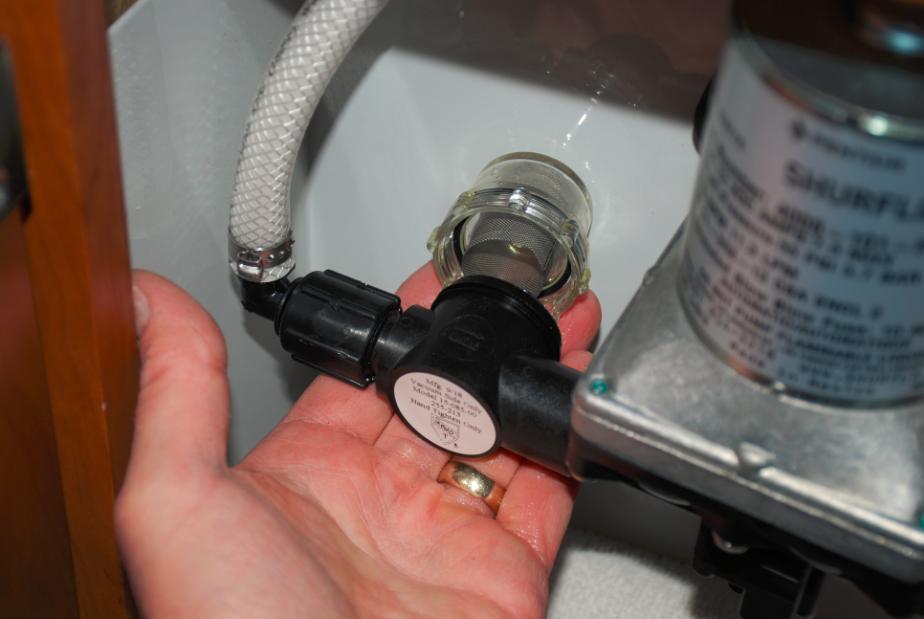
Add RV antifreeze to: - one of the kitchen sink traps
- the bathroom sink trap
- the shower trap
- Pour an adequate amount into one of the sinks to treat whatever remains in your grey water tank.
- Add RV antifreeze to the toilet, letting some wet the floor of the black tank, and leave some to cover the flush ball valve.
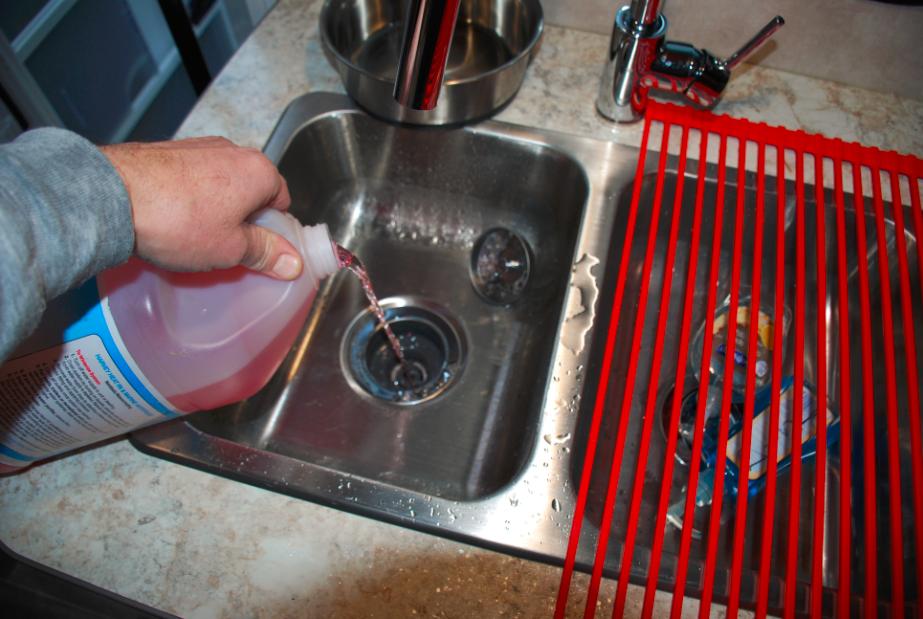
When Recharging the system for use: - Hook-up to City Fill to purge the air out of the system lines and the hot water tank.
- Completely fill the fresh water tank with 45 gallons.
- Switch-on the water pump and re-purge.
IMPORTANT: You must completely fill the fresh water tank to get the water level high enough to prime the water pump. Because the water filter of the water pump was drained, the pump will not self-prime with just a few gallons in the fresh water tank.
Eagle5
__________________
2019 Minnie Winnie 22M on an E-450 frame
|

|

|
 02-13-2020, 09:35 AM
02-13-2020, 09:35 AM
|
#2
|
|
Winnebago Master
Join Date: Jan 2020
Posts: 1,354
|
Quote:
Originally Posted by Eagle5

To keep my water lines clean, I purchased a new oil-free compressor and a new hose.
|
Nice description. I would just suggest a few things.
First, the order that you blow out fixtures should be from the closest to the fill to the furthest if you can determine that. Also, don't forget the outside shower if you have one.
Second, if the water heater has winterization bypass valves I would set them to bypass. Otherwise you're going to need to reinstall the water heater plug and it would take a ton of air to blow out the hot water side. I can blow out my entire system with just the air in my compressor (I don't have electricity where I store.)
Finally, I'm just not comfortable using just the blow out method. I use the water pump siphon hose to put a bit of antifreeze into the pump and lower lines. I don't do enough to get antifreeze to any fixture. My main concern is the pump.
|

|

|
 02-13-2020, 01:16 PM
02-13-2020, 01:16 PM
|
#3
|
|
Site Team
Join Date: Mar 2019
Location: South Bend, WA
Posts: 2,770
|
I totally understand the concern about clearing the water out of the pump. I think that in this 22M application, the only water trapped in the pump is drained with the above process, but I'm not 100% sure. I do run a pancake heater in the motorhome year-round, and it stays next to the water pump area. Also, it usually doesn't get that much below freezing in South Bend, as we are only 13 miles from the Pacific Ocean. If we do get an Easterly wind and it gets down into the 20s, I turn on additional electric heat, just to be sure.
__________________
2019 Minnie Winnie 22M on an E-450 frame
|

|

|
 02-13-2020, 04:19 PM
02-13-2020, 04:19 PM
|
#4
|
|
Winnebago Master
Join Date: Jan 2020
Posts: 1,354
|
I'm not sure about mine either, but since I need antifreeze for the drains it's not that much harder to run a bit through the pump. Also another thing I'm not sure of--it might make priming the pump easier when you fill with water???????
|

|

|
 02-13-2020, 04:21 PM
02-13-2020, 04:21 PM
|
#5
|
|
Site Team
Join Date: Mar 2019
Location: South Bend, WA
Posts: 2,770
|
The pump will self-prime, but only if you totally fill the 45 gallon fresh water tank first. Just a few gallons in the fresh water tank will not do it.
__________________
2019 Minnie Winnie 22M on an E-450 frame
|

|

|
 02-19-2020, 06:23 PM
02-19-2020, 06:23 PM
|
#6
|
|
Winnebago Owner
Join Date: Dec 2013
Posts: 122
|
Nice write up. I’m sure it’s pretty much what everyone does. There are two schools of thought on blowing out the lines. Some say furthest lines first and others say closest first. I go furthest but it probably doesn’t make any difference. After the lines are blown out the only water will be in the traps and whatever went into the gray tank. Neither will cause a problem and there is no need to add antifreeze. The only way water lines will break is if they are full and the weather expands at freezing and cracks the pipes. PEX pipe will normally expand enough to prevent breaks but we don’t take chances so we blow them out. The water in the traps will not damage them because the water has room to expand if frozen. If you fill up a plastic milk bottle half full and put it in your freezer it won’t split. I know it’s hard to not put in the antifreeze but it’s really not necessary.
|

|

|
 02-19-2020, 06:53 PM
02-19-2020, 06:53 PM
|
#7
|
|
Site Team
Join Date: Mar 2019
Location: South Bend, WA
Posts: 2,770
|
We did break a tub trap, or at least its caulking material, in our beach cottage in 1965, due to freezing weather. I suspect that the material used for the trap back then was less flexible than modern materials. What you say does make sense.
Thanks, Eagle5
__________________
2019 Minnie Winnie 22M on an E-450 frame
|

|

|
 02-19-2020, 07:36 PM
02-19-2020, 07:36 PM
|
#8
|
|
Winnebago Master
Join Date: Nov 2018
Location: Pflugerville/Austin, Tx
Posts: 8,613
|
Small point but I do not favor leaving any drains open, especially the fresh water tank as it may lead to ants moving in!
|

|

|
 02-19-2020, 10:57 PM
02-19-2020, 10:57 PM
|
#9
|
|
Site Team
Join Date: Mar 2019
Location: South Bend, WA
Posts: 2,770
|
The ants certainly could be a concern in some regions. I was leaving the drains open, because when I maneuver the motorhome to park it, some trace amount of water wetting the bottom of the fresh water tank would still drain-out. I guess once it is in its final parking place, it would be save to close all valves, as further tank & line draining would be unlikely with the vehicle in a static state.
Thanks, Eagle5
__________________
2019 Minnie Winnie 22M on an E-450 frame
|

|

|
 02-20-2020, 08:53 AM
02-20-2020, 08:53 AM
|
#10
|
|
Winnebago Camper
Join Date: Nov 2018
Posts: 9
|
nice write up. i set my air pressure to about 15-20 psi when doing my view.
|

|

|
 02-20-2020, 10:43 AM
02-20-2020, 10:43 AM
|
#11
|
|
Winnebago Master
Join Date: Jan 2020
Posts: 1,354
|
Quote:
Originally Posted by 09 harley

Nice write up. Iím sure itís pretty much what everyone does. There are two schools of thought on blowing out the lines. Some say furthest lines first and others say closest first. I go furthest but it probably doesnít make any difference. After the lines are blown out the only water will be in the traps and whatever went into the gray tank. Neither will cause a problem and there is no need to add antifreeze. The only way water lines will break is if they are full and the weather expands at freezing and cracks the pipes.
|
Even though I disagree with you on the order to blow out, I agree with your overall analysis and that it probably doesn't make much difference due to your freezing analysis. The reason I like closest first though is you won't possibly be pushing water further back after you've cleared it. Unless there's an extended low spot though I don't see that it matters.
|

|

|
 11-27-2020, 11:53 AM
11-27-2020, 11:53 AM
|
#12
|
|
Winnebago Master
Join Date: Jun 2020
Location: Dallas, Texas
Posts: 1,172
|
Few tidbits, not addressed to anyone in particular...
1. When I pour Anti Freeze in my P traps, it has NOT been for freeze protection; rather since I use my coach year around; I know that the P traps are full unless driven to control any potential odors, same for toilet. The fact that it is antifreeze, I know that the water will not freeze no matter where it might end up.
2. Does anyone blow out the water heater tank? Or is it assume that blowing out the main city fill line will blow out both?
3. When I do blowout, I quickly run inside the RV so I turn on first faucet I can get to and so on. It happens to be in order of closest 1st. My furthest out; I do last as I have to go back outside to my outdoor kitchen. By then my adrenaline and rush has kind of slowed down  I never tried to blow out with just 6 gallons, but I am sure I would run out of air; so I may be over doing?
4. The antifreeze siphon is only thing I have yet to ever use on the RV  If I lived off Lake Michigan or Minnesota some place, I would prolly see things different
5. Also, I learned a little while back that just because you have drained your tanks and they may appear drip dry, it does not mean they are empty. Each coach may be different but liquids may still be in the tanks and with some movement of RV; the liquids may flow down to main sewer drain valves. Another benefit of pouring antifreeze in the drain lines and toilet.
6. Like Eagle5, and his excellent write up, I too have found it helpful to leave my freshwater tank drains lines open. I drive it if possible, or wait a day or two before closing valves. I don't know if it is due to condensation, residuals on the wall of tank, but it is water that will accumulate and can freeze if not fully drained or blown out.
__________________
2019 Sunstar 29ve; Toad Lincoln Navigator; RVi3/Tire Patrol; Roadmaster Baseplate/Nighthawk; Sumo Springs; Safe T Plus; EC-30 AGS; 300ah Lithium; Victron Orion XS, SmartShunt; T-Mobile Internet; Southwire EMS; Jet Flo Macerator; Alpine SPE500; Visio M21D-H8R
|

|

|
 11-27-2020, 12:02 PM
11-27-2020, 12:02 PM
|
#13
|
|
Winnebago Master
Join Date: Jun 2020
Location: Dallas, Texas
Posts: 1,172
|
Quote:
Originally Posted by Morich

Small point but I do not favor leaving any drains open, especially the fresh water tank as it may lead to ants moving in!
|
We are in Texas, our Fire Ants won't waste time going for a simple water tank, they are going to go upfront (inside) to the main cabin and take the fridge 
When I was closing mine, it seems like every day for about a week, I could re-open the next day and more water would drain out? If I leave open a day or two and then close, it is dry. To add to my circumstance, my water pump has to be on to drain / pump water from my freshwater tank. I don't think it is 100% efficient? I really don't know, but that has been my experience.
__________________
2019 Sunstar 29ve; Toad Lincoln Navigator; RVi3/Tire Patrol; Roadmaster Baseplate/Nighthawk; Sumo Springs; Safe T Plus; EC-30 AGS; 300ah Lithium; Victron Orion XS, SmartShunt; T-Mobile Internet; Southwire EMS; Jet Flo Macerator; Alpine SPE500; Visio M21D-H8R
|

|

|
 11-27-2020, 01:35 PM
11-27-2020, 01:35 PM
|
#14
|
|
Winnebago Owner
Join Date: Mar 2020
Posts: 77
|
Quote:
Originally Posted by dkoldman

Few tidbits, not addressed to anyone in particular...
2. Does anyone blow out the water heater tank? Or is it assume that blowing out the main city fill line will blow out both?
|
Thanks everyone for this description and additional comments.
My experience just now on our 1706FB is that I drained all the tanks via gravity, including the water heater tank before a friend and I chanced upon this method of blowing out the plumbing. After rigging up a line from an old portable air compressor, I blew out all of the lines again and noticed more water coming out of the water heater drain at the same time I got water out of the various faucets and fresh water tank drain. So I can confirm that to at least some extent, blowing out the shore water will blow out more water from the heater tank than just a gravity drain.
What I haven't done yet is set the water heater bypass valves to bypass.
I'm curious about the need for that since we're heading out on a trip the first week of December and we'll see a couple of nights in the low to mid-20s next week before we leave. I'm thinking with everything blown out as much as I've done, I should be okay (using the half-empty milk bottle analogy, above...). And for safety, I may just run the furnace those two nights when it's in the 20s. Lows the following week when we're camping should be around freezing; I'm not worried about that beyond maybe disconnecting the water hose from the inlet at night.
Does this sound reasonable?
Thanks in advance!
Edit to add: maybe I just wasn't paying attention when I was 16, but I never remember dad winterizing our Holiday Rambler back in the 70s. Anyone from back then still around to confirm either way?
__________________
2019 1706FB Micro Minnie/2011 Z71 Chevy Suburban
"What the long road steals in minutes, it returns in serenity."
|

|

|
 11-27-2020, 02:41 PM
11-27-2020, 02:41 PM
|
#15
|
|
Winnebago Master
Join Date: Jun 2020
Location: Dallas, Texas
Posts: 1,172
|
Quote:
Originally Posted by Trout One

Thanks everyone for this description and additional comments.
My experience just now on our 1706FB is that I drained all the tanks via gravity, including the water heater tank before a friend and I chanced upon this method of blowing out the plumbing. After rigging up a line from an old portable air compressor, I blew out all of the lines again and noticed more water coming out of the water heater drain at the same time I got water out of the various faucets and fresh water tank drain. So I can confirm that to at least some extent, blowing out the shore water will blow out more water from the heater tank than just a gravity drain.
What I haven't done yet is set the water heater bypass valves to bypass.
I'm curious about the need for that since we're heading out on a trip the first week of December and we'll see a couple of nights in the low to mid-20s next week before we leave. I'm thinking with everything blown out as much as I've done, I should be okay (using the half-empty milk bottle analogy, above...). And for safety, I may just run the furnace those two nights when it's in the 20s. Lows the following week when we're camping should be around freezing; I'm not worried about that beyond maybe disconnecting the water hose from the inlet at night.
Does this sound reasonable?
Thanks in advance!
Edit to add: maybe I just wasn't paying attention when I was 16, but I never remember dad winterizing our Holiday Rambler back in the 70s. Anyone from back then still around to confirm either way?
|
Sounds very reasonable.
Few more scattershooting points.... I hope I don't come under fire by the RV Police 
1. I use my Water Heater Bypass quite frequently. I use when I know I will NOT need any hot water. This assures me that If I do add freshwater later to use RV freshwater; the water will not go back into water heater tank.
2. I put a ON/OFF Switch on my water heater outside; so when I do winterize the heater, I can turn off from outside; so it is impossible to turn from the inside. You might call it Safety overkill, but I rather my switch keeps it off than the water heater's heater safety protect turning it off from overheating. I have Gas only heater.
3. Despite all of the above draining and blowout winterization, whenever temperature is forecasted to drop below 28, I turn my gas heat on inside the coach at lowest possible setting. Because I am fortunate to have my RV parked at home it is fairly easy to monitor. We have yet to use portable electric heaters inside the RV. I fear they may over heat the electrical so I try to avoid. Thus far it has been no need.
4. Next time I fill my water heater, you have motivated me to try new experiment  Sometimes; I love to play just to see what if?
I will drain and blowout everything like normal including water heater. When I think I am completely finished. I will close up City Fill and put blow out plug in water heater directly to see if any more comes out of the hot water faucets in RV?
5. A lot of people including my selling Winnebago dealer did not believe me, but my RV fresh water tank will NOT gravity drain. Sure all of the low point lines do gravity drain, but water will not come out of fresh water tank unless the water pump is on. The good news is that when pump is on, it drains that tank fast. My dealer is about 1500 miles away and they all but called me an idiot; when I got it home last winter brand spanking new, I could not drain per their instructions  Took one call to Winnebago and they quickly noted that I had the wrong version of manual and that dealer's instructions were wrong. Winnebago sent me a new custom manual in the binders for my coach's serial number in a couple of days  Don't know what other Mfgs do, but after 1 year, I really love Winnebago Ind 
__________________
2019 Sunstar 29ve; Toad Lincoln Navigator; RVi3/Tire Patrol; Roadmaster Baseplate/Nighthawk; Sumo Springs; Safe T Plus; EC-30 AGS; 300ah Lithium; Victron Orion XS, SmartShunt; T-Mobile Internet; Southwire EMS; Jet Flo Macerator; Alpine SPE500; Visio M21D-H8R
|

|

|
 11-27-2020, 05:02 PM
11-27-2020, 05:02 PM
|
#16
|
|
Winnebago Owner
Join Date: Mar 2020
Posts: 77
|
Quote:
Originally Posted by dkoldman

Sounds very reasonable.
...A lot of people including my selling Winnebago dealer did not believe me, but my RV fresh water tank will NOT gravity drain. Sure all of the low point lines do gravity drain, but water will not come out of fresh water tank unless the water pump is on. The good news is that when pump is on, it drains that tank fast...
|
Forgot to mention that. I unplugged shore power and ran the remaining fresh water out of the faucets as for as I felt comfortable doing that with the water pump. Since it's water cooled, I didn't run it until there was no water coming out of the faucets. I was afraid I'd burn it up. I've left the remainder to gravity and whatever the compressor will blow out.
I'm buying a new ARB compressor for the truck next year. Going to be curious how it does with this exercise. It will inflate a 35" tire in 2 minutes; I figure it should clear some lines pretty quickly.
__________________
2019 1706FB Micro Minnie/2011 Z71 Chevy Suburban
"What the long road steals in minutes, it returns in serenity."
|

|

|
 11-27-2020, 05:27 PM
11-27-2020, 05:27 PM
|
#17
|
|
Winnebago Master
Join Date: Jun 2020
Location: Dallas, Texas
Posts: 1,172
|
Quote:
Originally Posted by Trout One

Forgot to mention that. I unplugged shore power and ran the remaining fresh water out of the faucets as for as I felt comfortable doing that with the water pump. Since it's water cooled, I didn't run it until there was no water coming out of the faucets. I was afraid I'd burn it up. I've left the remainder to gravity and whatever the compressor will blow out.
I'm buying a new ARB compressor for the truck next year. Going to be curious how it does with this exercise. It will inflate a 35" tire in 2 minutes; I figure it should clear some lines pretty quickly.
|
You gonna keep me busy when I next add fresh water and wish to drain  Theoretically on my RV I could disconnect the water pump (suction side) and all of my water would drain? But if it did, it would all go into my wet bay and make a mess. Don't quote me, but we could confirm with Shurflo... but I believe my pump can run a little while when dry? I just run it until it start to spits water out of the low point drain. I then blow it out to get air through all of the faucets. (I have 6 gal Bostitch Compressor, use it all the time) I can close the drain valves, but the next morning I still have water that will drain out. I am leaning to adding a last step to disconnect suction line to the pump and then closing my valves? My tank would still be exposed, but some critter would have to be in the wet bay to get access to the open hose to crawl into my tank.
__________________
2019 Sunstar 29ve; Toad Lincoln Navigator; RVi3/Tire Patrol; Roadmaster Baseplate/Nighthawk; Sumo Springs; Safe T Plus; EC-30 AGS; 300ah Lithium; Victron Orion XS, SmartShunt; T-Mobile Internet; Southwire EMS; Jet Flo Macerator; Alpine SPE500; Visio M21D-H8R
|

|

|
 11-28-2020, 09:49 AM
11-28-2020, 09:49 AM
|
#18
|
|
Winnebago Master
Join Date: Jun 2020
Location: Dallas, Texas
Posts: 1,172
|
Update:
I went out to RV this morning and I see an alternative to leaving the drain valves opened for a day or two. Note: My RV was winterized about a month ago. There have been no freezes.
If you unscrew the strainer / filter from vacuum side of pump it will allow to drain any water that may be left in the tank. I actually got about 12 oz of water!!!! I have two pumps, the other had about 2 oz (outside kitchen sink pump; so no tank)
As a bonus it was a good time to clean both strainers 
So in future, when winterizing I will add the step to remove strainers. I will still leave my drains valves open for a while; but may close them well before I put strainers back on.
Note: Put a bowl underneath the strainer to catch the water that may come out
__________________
2019 Sunstar 29ve; Toad Lincoln Navigator; RVi3/Tire Patrol; Roadmaster Baseplate/Nighthawk; Sumo Springs; Safe T Plus; EC-30 AGS; 300ah Lithium; Victron Orion XS, SmartShunt; T-Mobile Internet; Southwire EMS; Jet Flo Macerator; Alpine SPE500; Visio M21D-H8R
|

|

|
 11-28-2020, 11:14 AM
11-28-2020, 11:14 AM
|
#19
|
|
Winnebago Master
Join Date: Nov 2018
Location: Pflugerville/Austin, Tx
Posts: 8,613
|
Some info on the pump most of us have if we have not changed out the original pump:
https://www.pentair.com/en-us/produc...pass-pump.html
Item four on their list says can be run dry. The motor is actually not water but air cooled so not a factor on that part.
__________________
Richard
Why no RV year, make and floorplan on MY signature as we suggest for others?
I currently DO NOT have one! 
|

|

|
 11-28-2020, 02:02 PM
11-28-2020, 02:02 PM
|
#20
|
|
Winnebago Master
Join Date: Jun 2020
Location: Dallas, Texas
Posts: 1,172
|
Quote:
Originally Posted by Morich

|
"This is very nice critical need to know information" signed Burt Gummer 
This is very reassuring to me and will also explain why Winnebago put one of these pumps on my outside kitchen to pump the return gray water to my black tank. That pump's switch is activated by holding down; but as soon as you let go, it stops. I was always afraid of holding too long trying to pump the water out. I will no longer have that worry.
Shurflo pumps is one of those products you don't need warranties for. If they ever were to fail, buying another one to replace it is a no brainer and not a strain on your wallet. (pun intended  )
Thanks for sharing.
__________________
2019 Sunstar 29ve; Toad Lincoln Navigator; RVi3/Tire Patrol; Roadmaster Baseplate/Nighthawk; Sumo Springs; Safe T Plus; EC-30 AGS; 300ah Lithium; Victron Orion XS, SmartShunt; T-Mobile Internet; Southwire EMS; Jet Flo Macerator; Alpine SPE500; Visio M21D-H8R
|

|

|
 |
|
|
Currently Active Users Viewing This Thread: 1 (0 members and 1 guests)
|
|
|
 Posting Rules
Posting Rules
|
You may not post new threads
You may not post replies
You may not post attachments
You may not edit your posts
HTML code is Off
|
|
|
|
 » Recent Discussions
» Recent Discussions |
|
|
|
|
|
|
|
|
|
|
|
|
|
|
|
|
|
|
|
|
|
|
|
|
|